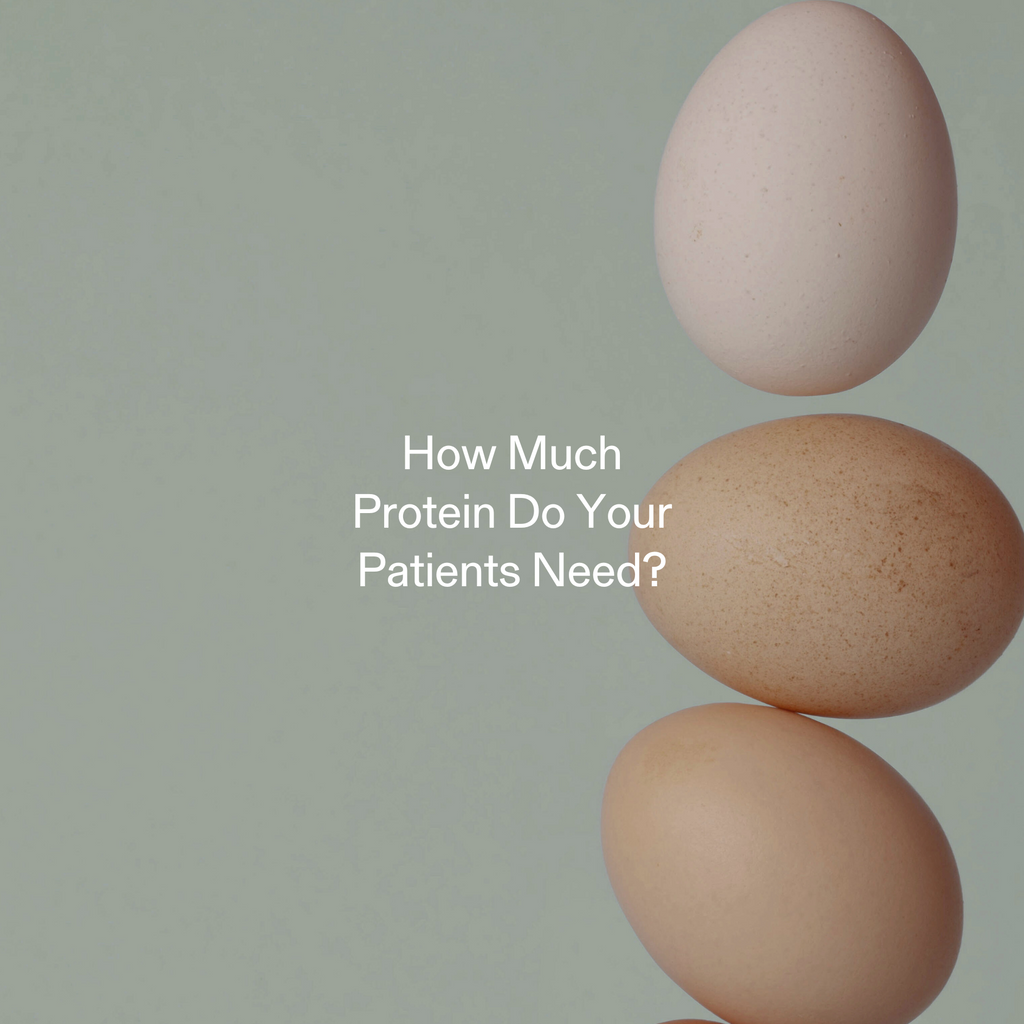As healthcare professionals working with patients seeking weight loss, you’ve likely encountered the frustrating scenario: a patient diligently follows a calorie-restricted diet, loses weight initially, then hits a plateau despite promising their continued compliance. While the insidious effect of food noise is an important factor in this (given that over half those trying to lose weight reported it makes sticking to a health diet or exercise plan more challenging),1 an often-overlooked role in these cases is that of adequate protein intake in preserving lean body mass during caloric restriction. In addition, although the use of glucagon-like-peptide-1 receptor agonists (GLP-1 RAs) has made a huge impact on successful weight loss, they come with limitations for many users, whether due to cost, side-effects or other factors.
The use of GLP-1 RAs has highlighted the loss of lean body mass that occurs with the use of these drugs. Indeed, based on their pivotal weight loss studies, the amount of muscle or lean mass lost each year when using semaglutide or tirzepatide has been estimated at around 10% and 8%, respectively.2 Furthermore, the discontinuation rate after taking GLP-1 RAs remains high and rebound weight gain is common; such patients are likely to regain body fat rather than replace their lost muscle.2
The difference between successful, sustainable weight loss and the all-too-common cycle of weight regain may thus lie not just with prescription medications, but also in providing adequate protein recommendations and the use of other agents to increase satiety and reduce food noise.
The challenge of maintaining muscle mass while creating the energy deficit necessary for fat loss represents one of the most important clinical considerations in weight management. Yet many practitioners continue to rely on outdated protein recommendations that may be inadequate for patients undergoing intentional weight loss. This article examines the evolving evidence for higher protein intakes during caloric restriction and provides practical guidance for optimizing protein recommendations in clinical practice.
The Critical Role of Protein in Body Composition
Protein's Functions in Muscle Metabolism
Understanding protein's role in muscle preservation requires familiarity with the dynamic balance between muscle protein synthesis (MPS) and muscle protein breakdown (MPB). Under normal circumstances, these processes exist in equilibrium, with net protein balance remaining neutral or slightly positive with a daily turnover rate of ~1.5%.3 However, caloric restriction tilts this balance toward catabolism, primarily from reduced MPS but also from increased MPB, as the body seeks to meet energy demands such through the breakdown of existing tissue.3
Dietary protein serves as the primary stimulus for MPS, providing both the amino acid building blocks necessary for new protein formation and the leucine-mediated signaling required to initiate the synthetic process. During periods of energy restriction, adequate protein intake becomes even more critical as it helps counteract the increased protein breakdown that occurs when the body mobilizes stored energy.
Other Roles of Protein
Beyond its structural function, muscle protein provides a source of amino acids that have multiple physiological roles, including energy production, gluconeogenesis, and the synthesis of peptide hormones, enzymes, plasma proteins and immune system components (Figure 1).4
As well, protein significantly impacts metabolic rate through its high thermic effect of food (TEF). Protein metabolism uses approximately 20–30% of its consumed calories for digestion, absorption, and utilization—substantially higher than carbohydrates (5–10%) or fats (0–3%).5
Protein also plays a crucial role in appetite regulation through multiple mechanisms. It enhances satiety more effectively than other macronutrients, through both its high TEF values5 and also its effects on hormones such as GLP-1, cholecystokinase (both raised after high-protein meals), and ghrelin (reduced after high-protein meals).6 In addition, high protein meals have been shown to reduce the activation of areas of the CNS that control food motivation, reward and cravings.6 For patients struggling with hunger and adherence during caloric restriction, optimizing protein intake can thus be a valuable tool for improving compliance
Consequences of Muscle Mass Loss During Weight Loss
The preservation of lean body mass during weight loss extends far beyond aesthetic concerns. Loss of muscle tissue during caloric restriction carries significant metabolic and functional consequences that can undermine both immediate weight loss efforts and long-term weight maintenance.
Perhaps most critically, muscle tissue is metabolically active, contributing approximately 20–30% of total daily energy expenditure in healthy adults.7,8 The loss of lean body mass during weight loss results in a proportional decrease in metabolic rate that persists beyond the period of active weight loss. Furthermore, this “adaptive thermogenesis” results in a reduced total daily energy expenditure of 20–25% in lean or obese people who maintain a 10% weight loss,9 making weight maintenance increasingly difficult.
The functional and physiological implications of muscle loss are equally concerning, particularly for older adults. Sarcopenia associated with weight loss can accelerate age-related decline in strength, mobility, and independence (Box 1).

Perhaps most concerning from a long-term perspective is the relationship between muscle loss and weight regain. Patients who lose significant lean body mass during weight loss face the dual challenge of reduced metabolic rate and diminished capacity for physical activity. This combination creates a metabolic environment highly conducive to weight regain, contributing to the disappointing long-term success rates observed in many weight loss interventions.
Current Protein Recommendations
Standard RDA Guidelines
The current Recommended Dietary Allowance (RDA) for protein stands at 0.8 g/kg body weight per day for adults, a recommendation that has remained largely unchanged for decades. This value was established based on nitrogen balance studies in healthy young adults designed to determine the minimum protein intake; it overestimates the amount of nitrogen ingested and underestimates that excreted.18 While this approach successfully identifies the protein requirement to maintain nitrogen equilibrium, it does not reflect the optimal intake for individuals undergoing the metabolic stress of caloric restriction. In addition, the RDA is the amount of protein necessary to prevent deficiency in healthy, weight-stable adults and should perhaps be more accurately described as a minimum required intake.
The methodology used to establish the RDA has several limitations when applied to weight loss contexts. Nitrogen balance studies, while useful for determining minimum requirements, do not capture the full picture of protein metabolism during energy restriction. These studies typically examine short-term responses in metabolically healthy individuals and may not account for the increased protein turnover and altered amino acid metabolism that occur during sustained caloric deficit.18
Furthermore, the RDA represents a population-based recommendation designed to meet the needs of 97.5% of healthy individuals.19 This statistical approach, while appropriate for public health guidance, may not provide optimal recommendations for specific clinical populations, including those undergoing intentional weight loss. Many internationally recognized professional organizations therefore recommend protein intake around double that of the RDA, at 1.2–2.0 g/kg/day.4
Existing Clinical Guidelines for Weight Loss
Current clinical guidelines for weight management have begun to acknowledge the importance of higher protein intakes during caloric restriction. For those on a moderate weight loss diet with 500–750 kcal/day deficit, protein intakes of 1.6 g/kg/day are recommended, in order to preserve muscle mass.4
However, a significant gap exists between these evolving clinical recommendations and actual practice patterns. It’s important to emphasize to patients that a reduction in total calorie intake is only part of the equation, and that adequate protein intake is a prerequisite for successful weight management.
Special Considerations for Different Patient Populations
The optimal protein intake during weight loss varies considerably based on patient characteristics, with certain populations requiring particularly careful consideration.
Older adults represent a special population with increased protein needs during weight loss. Age-related changes in protein metabolism, including decreased protein synthesis efficiency and increased resistance to anabolic stimuli, suggest that older adults may require protein intakes of 1.2–1.6 g/kg body weight even during weight maintenance.20 Thus, for older adults undergoing weight loss, these needs may increase further.
Highly active individuals and athletes require special consideration, as exercise training increases protein requirements even during energy balance. Athletes undergoing weight loss may benefit from protein intakes of 1.8–2.7 g/kg body weight to maintain performance and muscle mass during caloric restriction.21
For patients with chronic kidney disease, low-protein intakes of 0.6–0.8 g/kg/day are recommended.22 However, there is no evidence that higher protein intake harms the kidneys in those with normal renal function, no matter the source of the protein.4 Nevertheless, given that almost 50% of those aged 70 years or older have chronic kidney disease (and 90% of them may be unaware of it),22 it’s important to measure baseline renal function before recommending higher protein diets in older patients.
Protein Quality and Timing Strategies
Optimal Protein Sources
The source and quality of dietary protein significantly influence its effectiveness for muscle preservation during weight loss. Complete proteins containing all essential amino acids in adequate proportions are generally superior to incomplete proteins for supporting muscle protein synthesis.
The leucine content of protein sources appears particularly important for stimulating muscle protein synthesis and inhibiting its breakdown.23 Animal proteins typically contain higher leucine levels than plant proteins, with certain dairy products being particularly rich in this amino acid.24
The relative benefits of animal- versus plant-based protein have been inconsistent in observational studies but may favor the former.22
Distribution and Timing
The distribution of protein intake throughout the day appears to influence its effectiveness for muscle preservation; in fact, in one study, 24-hour muscle protein synthesis was ∼25% greater when protein intake was evenly distributed.25 Thus, an easy way to increase protein intake is to advise patients to increase their consumption at breakfast and lunch, given that it’s typically skewed to the evening meal.22 Nevertheless, eating at least one high-protein meal a day may be enough to preserve skeletal muscle.22
Encourage an Exercise Program
Increased protein intake is just one part of a two-pronged regimen to maintain lean muscle mass. The other important factor is promoting resistance training to promote skeletal muscle anabolism.22 Patients should be evaluated for specific factors such as their age, cardiovascular risk factors, joint health and mobility, amongst others.2 Weekly exercise should include at least 150–300 minutes of moderate exercise or 75–150 minutes of vigorous exercise, in addition to muscle-strengthening that exercises all the major muscle groups at least twice a week.2
Practical Implementation in Clinical Practice
Assessment and Goal Setting
Implementing higher protein recommendations requires a systematic approach to assessment and goal setting. Begin by calculating individualized protein targets based on current body weight, age, activity level, and specific health conditions. For most patients undergoing weight loss, a target of 1.2–1.6 g/kg body weight per day represents a reasonable starting point, with adjustments based on individual response and specific circumstances.
Body composition assessment, when available, can provide valuable information for refining protein recommendations. Patients with higher muscle mass may benefit from higher protein intakes, while those with lower muscle mass may require more aggressive protein targets to prevent further loss.
Consider using adjusted body weight calculations for patients with significant obesity. A commonly used formula adds 25% of the excess weight above ideal body weight to the ideal body weight, then calculates protein needs based on this adjusted value. This approach prevents excessive protein recommendations while ensuring adequate intake for muscle preservation.
Regular monitoring of progress using both objective and subjective measures helps guide ongoing adjustments to protein recommendations. Body composition changes, strength assessments, functional measures, and patient-reported outcomes all provide valuable feedback on the effectiveness of protein interventions.
Addressing Common Challenges
Cost represents a significant barrier for many patients seeking to increase protein intake. Animal proteins, particularly high-quality options like lean meats and fish, can be expensive and may not be accessible to all patients. Providing guidance on economical protein sources such as eggs, canned fish, legumes, and generic protein powders can help address this barrier.
Gastrointestinal tolerance issues may arise with higher protein intakes, particularly for patients not accustomed to consuming substantial amounts of protein. Gradual increases in protein intake, adequate hydration, and attention to fiber intake can help minimize digestive discomfort. For patients with persistent issues, spreading protein intake across more frequent, smaller meals may improve tolerance.
Cultural and dietary preferences must be respected while working toward optimal protein intake. This requires familiarity with protein sources from various cultural traditions and creative approaches to incorporating adequate protein within preferred dietary patterns. Working with culturally competent dietitians can be invaluable for addressing these challenges.
The choice between whole food proteins and supplements depends on individual circumstances, preferences, and practical considerations. While whole foods provide additional nutrients and may offer superior satiety, supplements can be valuable tools for patients struggling to meet protein targets through food alone. High-quality protein powders can be particularly useful for post-exercise nutrition, convenient meal replacements, or addressing gaps in daily protein intake.
While high-protein diets can help reduce satiety, nevertheless, food noise, hunger, and cravings remain common issues for those trying to lose weight. It may be helpful to your patients to complement their weight loss plan with Calocurb®, a dietary supplement containing the bitter hops extract, Amarasate®. Amarasate stimulates bitter taste receptors on gut L-cells, which respond by releasing endogenous GLP-1 with subsequent increased satiety. In (human) clinical trials, Amarasate decreased hunger by 30%, cravings by 40% and calorie intake by 18%.26,27 It is currently being compared to placebo for weight loss in a six-month, double-blind clinical trial that includes body mass scanning.
Monitoring and Adjusting Protein Interventions
Effective monitoring of protein interventions requires attention to multiple parameters that reflect both muscle preservation and overall health status. Body composition assessment using DEXA scan, bioelectrical impedance analysis, or other validated methods provides the most direct measure of lean body mass changes over time.
Functional assessments offer valuable insights into the real-world impact of muscle preservation efforts. Simple measures such as grip strength, chair rise time, or walking speed can provide clinically meaningful information about changes in muscle function. These assessments are particularly valuable for older adults, where functional preservation may be more important than absolute muscle mass.
Laboratory monitoring should include markers of protein status and kidney function, particularly for patients consuming higher protein intakes. Serum albumin and prealbumin can provide information about protein status, though these markers are influenced by factors beyond dietary protein intake. Regular monitoring of serum creatinine and estimated glomerular filtration rate is prudent for patients with risk factors for kidney disease.
Patient-reported outcomes, including energy levels, appetite control, and perceived strength, provide important subjective measures of intervention effectiveness. These measures often change before objective parameters and can guide early adjustments to protein recommendations.
Adjustments to protein targets should be based on response patterns observed over 4–8 weeks of consistent intervention. Patients showing signs of excessive muscle loss despite adequate protein intake may benefit from higher protein targets, while those experiencing gastrointestinal intolerance or other adverse effects may require modifications to timing or source recommendations.
Clinical Takeaways
The evidence supporting higher protein intakes during weight loss continues to strengthen, with clear benefits demonstrated for muscle preservation, metabolic rate maintenance, and long-term weight management success. For most patients undergoing caloric restriction, protein intakes of 1.2–1.6 g/kg body weight per day represent a reasonable target, with higher intakes potentially beneficial for older adults, highly active individuals, or those with significant muscle loss.
Implementation of these recommendations requires attention to protein quality, distribution throughout the day, and individual patient factors that may influence optimal intake levels. While challenges exist in terms of cost, tolerance, and dietary preferences, these can often be addressed through creative approaches and individualized counseling.
The integration of adequate protein intake into comprehensive weight management programs represents a critical component of evidence-based care. Rather than viewing protein recommendations as an add-on to caloric restriction, practitioners should consider adequate protein intake as a foundational element of successful weight loss interventions. In addition, whether they’re taking a GLP-1 RA for weight loss or not, it may be useful for patients to supplement with Calocurb, to further reduce hunger and food noise and to help maintain production of endogenous GLP-1.
The success of weight loss interventions ultimately depends on our ability to preserve the metabolically active tissue that supports long-term weight maintenance. By optimizing protein intake during caloric restriction, we can help patients achieve not just weight loss, but sustainable improvements in body composition and metabolic health that support lifelong wellness.
Key Clinical Recommendations by Patient Population

Examples of the role of amino acids. From Carbone et al, 20194

Key: AA, amino acids; ADH, antidiuretic hormone; hGH, human growth hormone; T3, triiodothyronine; T4, thyroxine.
References
- Stop Obesity Alliance and WeightWatchers. Beyond hunger: understanding food noise. Redstone Global Center for Prevention and Wellness, George Washington University, and WeightWatchers. Published January 31, 2024. https://v.cdn.ww.com/media/system/cms/us/pdf-archive/WeightWatchers_Consumer_Landing_Page_2024.pdf?_gl=1*18hipvo*_gcl_au*MjAwOTQzNjM0OS4xNzQ1MDIzMDU3
- Mechanick JI, Butsch WS, Christensen SM, et al. Strategies for minimizing muscle loss during use of incretin-mimetic drugs for treatment of obesity. Obes Rev. 2025;26(1):e13841. doi:10.1111/obr.13841
- Janssen TAH, Van Every DW, Phillips SM. The impact and utility of very low-calorie diets: the role of exercise and protein in preserving skeletal muscle mass. Curr Opin Clin Nutr Metab Care. 2023;26(6):521-527. doi:10.1097/MCO.0000000000000980
- Carbone JW, Pasiakos SM. Dietary Protein and Muscle Mass: Translating Science to Application and Health Benefit. Nutrients. 2019;11(5):1136. Published 2019 May 22. doi:10.3390/nu11051136
- Westerterp KR. Diet induced thermogenesis. Nutr Metab (Lond). 2004;1(1):5. Published 2004 Aug 18. doi:10.1186/1743-7075-1-5
- Paddon-Jones D, Leidy H. Dietary protein and muscle in older persons. Curr Opin Clin Nutr Metab Care. 2014;17(1):5-11. doi:10.1097/MCO.0000000000000011
- Mason JB. Nutritional assessment and management of the malnourished patient. In: Feldman M, Friedman LS, Brandt LJ. Sleisenger and Fordtran's Gastrointestinal and Liver Disease : Pathophysiology / Diagnosis / Management. 9th ed Philadelphia, PA: Saunders / Elsevier; 2010:47-75.
- Katare PB, Dalmao-Fernandez A, Mengeste AM, et al. Energy metabolism in skeletal muscle cells from donors with different body mass index. Front Physiol. 2022;13:982842. Published 2022 Nov 17. doi:10.3389/fphys.2022.982842
- Rosenbaum M, Leibel RL. Adaptive thermogenesis in humans. Int J Obes (Lond). 2010;34 Suppl 1(0 1):S47-S55. doi:10.1038/ijo.2010.184
- Gitsi E, Kokkinos A, Konstantinidou SK, Livadas S, Argyrakopoulou G. The relationship between resting metabolic rate and body composition in people living with overweight and obesity. J Clin Med. 2024;13(19):5862. Published 2024 Oct 1. doi:10.3390/jcm13195862
- Srikanthan P, Karlamangla AS. Relative muscle mass is inversely associated with insulin resistance and prediabetes. Findings from the third National Health and Nutrition Examination Survey. J Clin Endocrinol Metab. 2011;96(9):2898-2903. doi:10.1210/jc.2011-0435
- Yeung SSY, Reijnierse EM, Pham VK, et al. Sarcopenia and its association with falls and fractures in older adults: A systematic review and meta-analysis. J Cachexia Sarcopenia Muscle. 2019;10(3):485-500. doi:10.1002/jcsm.12411
- Villareal DT, Chode S, Parimi N, et al. Weight loss, exercise, or both and physical function in obese older adults. N Engl J Med. 2011;364(13):1218-1229. doi:10.1056/NEJMoa1008234
- Yu C, Du Y, Peng Z, et al. Research advances in crosstalk between muscle and bone in osteosarcopenia (Review). Exp Ther Med. 2023;25(4):189. Published 2023 Mar 14. doi:10.3892/etm.2023.11888
- Tessier AJ, Wing SS, Rahme E, Morais JA, Chevalier S. Association of low muscle mass with cognitive function during a 3-year follow-up among adults aged 65 to 86 years in the Canadian Longitudinal Study on Aging. JAMA Netw Open. 2022;5(7):e2219926. Published 2022 Jul 1. doi:10.1001/jamanetworkopen.2022.19926
- He N, Zhang Y, Zhang L, Zhang S, Ye H. relationship between sarcopenia and cardiovascular diseases in the elderly: An overview. Front Cardiovasc Med. 2021;8:743710. Published 2021 Dec 9. doi:10.3389/fcvm.2021.743710
- Koon-Yee Lee G, Chun-Ming Au P, Hoi-Yee Li G, et al. Sarcopenia and mortality in different clinical conditions: A meta-analysis. Osteoporos Sarcopenia. 2021;7(Suppl 1):S19-S27. doi:10.1016/j.afos.2021.02.001
- Weiler M, Hertzler SR, Dvoretskiy S. Is It Time to Reconsider the U.S. Recommendations for Dietary Protein and Amino Acid Intake? Nutrients. 2023;15(4):838. Published 2023 Feb 6. doi:10.3390/nu15040838
- Dennett C. Great debates: Protein recommendations. Today’s Dietitian. 2025;27(5):26-31. Accessed August 5, 2025. https://www.todaysdietitian.com/newarchives/0525p26.shtml
- Bauer J, Biolo G, Cederholm T, et al. Evidence-based recommendations for optimal dietary protein intake in older people: a position paper from the PROT-AGE Study Group. J Am Med Dir Assoc. 2013;14(8):542-559. doi:10.1016/j.jamda.2013.05.021
- Helms ER, Zinn C, Rowlands DS, Brown SR. A systematic review of dietary protein during caloric restriction in resistance trained lean athletes: a case for higher intakes. Int J Sport Nutr Exerc Metab. 2014;24(2):127-138. doi:10.1123/ijsnem.2013-0054
- Campbell WW, Deutz NEP, Volpi E, Apovian CM. Nutritional interventions: Dietary protein needs and influences on skeletal muscle of older adults. J Gerontol A Biol Sci Med Sci. 2023;78(Suppl 1):67-72. doi:10.1093/gerona/glad038
- Garlick PJ. The role of leucine in the regulation of protein metabolism. J Nutr. 2005;135(6 Suppl):1553S-6S. doi:10.1093/jn/135.6.1553S
- Rondanelli M, Nichetti M, Peroni G, et al. Where to find leucine in food and how to feed elderly with sarcopenia in order to counteract loss of muscle mass: Practical advice. Front Nutr. 2021;7:622391. Published 2021 Jan 26. doi:10.3389/fnut.2020.622391
- Mamerow MM, Mettler JA, English KL, et al. Dietary protein distribution positively influences 24-h muscle protein synthesis in healthy adults. J Nutr. 2014;144(6):876-880. doi:10.3945/jn.113.185280
- Walker E, Lo K, Gopal P. Gastrointestinal delivery of bitter hop extract reduces appetite and food cravings in healthy adult women undergoing acute fasting. Obes Pillars. 2024;11:100117. Published 2024 Jun 20. doi:10.1016/j.obpill.2024.100117
- Walker EG, Lo KR, Pahl MC, et al. An extract of hops (Humulus lupulus L.) modulates gut peptide hormone secretion and reduces energy intake in healthy-weight men: a randomized, crossover clinical trial. Am J Clin Nutr. 2022;115(3):925-940. doi:10.1093/ajcn/nqab418
Bibliography
- Nunes EA, Colenso-Semple L, McKellar SR, et al. Systematic review and meta-analysis of protein intake to support muscle mass and function in healthy adults. J Cachexia Sarcopenia Muscle. 2022;13(2):795-810. doi:10.1002/jcsm.12922
- Bikou A, Dermiki-Gkana F, Penteris M, Constantinides TK, Kontogiorgis C. A systematic review of the effect of semaglutide on lean mass: insights from clinical trials. Expert Opin Pharmacother. 2024;25(5):611-619. doi:10.1080/14656566.2024.2343092
- Ishaq I, Noreen S, Aja PM, Atoki AV. Role of protein intake in maintaining muscle mass composition among elderly females suffering from sarcopenia. Front Nutr. 2025;12. doi:https://doi.org/10.3389/fnut.2025.1547325
- Maleky F, Ahmadi L. Adhering to recommended dietary protein intake for optimizing human health benefits versus exceeding levels. RSC Adv. 2025;15(12):9230-9242. Published 2025 Mar 25. doi:10.1039/d4ra08221d
- Kokura Y, Ueshima J, Saino Y, Maeda K. Enhanced protein intake on maintaining muscle mass, strength, and physical function in adults with overweight/obesity: A systematic review and meta-analysis. Clin Nutr ESPEN. 2024;63:417-426. doi:10.1016/j.clnesp.2024.06.030




